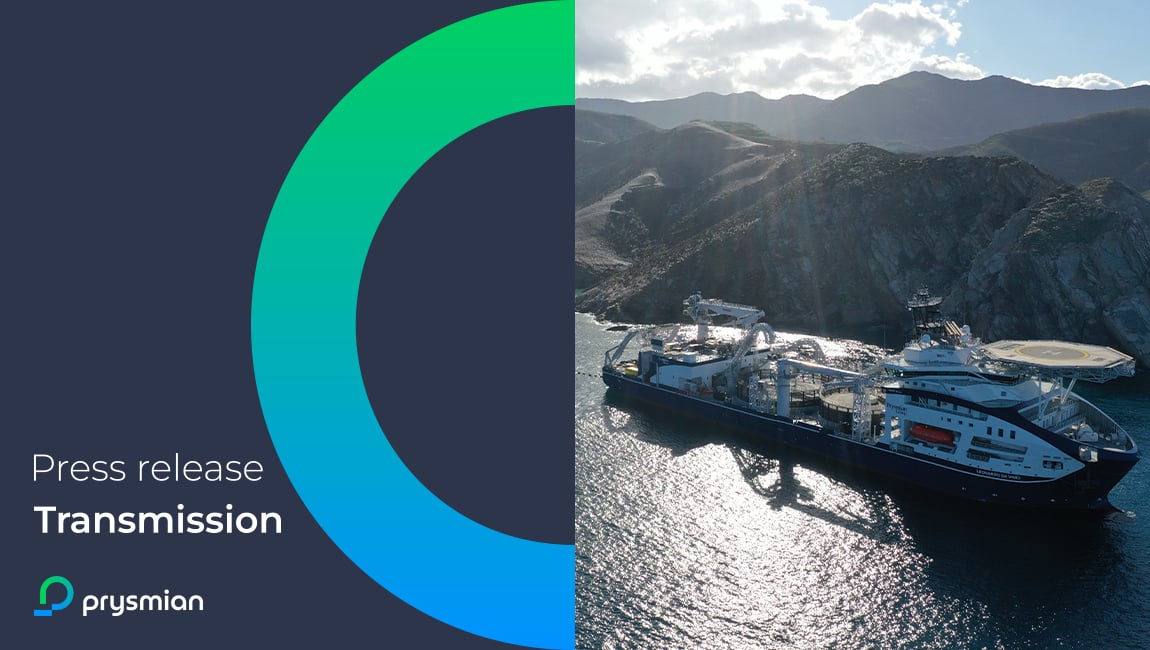Prysmian – Prysmian signs €600 million contract for Marinus link in Australia | Prysmian
The award follows the capacity reservation agreement announced in september 2023
Prysmian and Marinus Link Pty Ltd. have finalised an around €600 million contract for a new power interconnector between Victoria and Tasmania, Australia. The commencement of the works is subject to the issuance of a notice to proceed, which is expected by August 2025. This agreement follows the prior announcement of a capacity reservation agreement, communicated in September 2023. Link here.
The project’s cables will span 345 km – 255 km undersea across Bass Strait and 90 km underground in Gippsland, Victoria, with the completion date set for 2030.
With a capacity of 750 MW for the first stage, the Marinus Link will facilitate the flow of electricity and telecommunications between the two states, enabling an efficient transfer of power from the areas where renewable energy is generated to those where it is needed, and will help Australia meet its emissions reduction targets by saving up to 70 million tonnes of CO2 equivalent by 2050.
Prysmian will design, test, supply and install a HVDC (High Voltage Direct Current) cable system, consisting of 320 kV single-core cables with XLPE insulation and single-wire armouring, covering both submarine and land sections. Prysmian will also provide a fully integrated PRY-CAM permanent monitoring system.
Submarine cables will be produced at Prysmian’s centre of excellence in Arco Felice (Italy), while land cables will be produced in Delft (The Netherlands) or Gron (France). Installation operations will be delivered with Prysmian’s record-setting cable-laying vessel, the Leonardo da Vinci (discover more here) .
Hakan Ozmen, EVP Transmission at Prysmian said: “This project strengthens our global leadership, as well as our position in Oceania’s fast-growing renewables market. We are proud to support Australia in its goal to combine the benefits of renewable energy to deliver low-cost, reliable, and clean energy to customers.”
SourcePrysmian Group
EMR Analysis
More information on Prysmian: See the full profile on EMR Executive Services
More information on Massimo Battaini (Group Chief Executive Officer and General Manager, Prysmian Group): See the full profile on EMR Executive Services
More information on Hakan Ozmen (Executive Vice President, Transmission Business, Prysmian Group): See the full profile on EMR Executive Services
More information on PRY-CAM Technology by Prysmian: See the full profile on EMR Executive Services
More information on Leonardo da Vinci by Prysmian: https://www.prysmiangroup.com/en/new-vessel-leonardo-da-vinci + https://www.prysmiangroup.com/sites/default/files/atoms/files/Leonardo_da_Vinci_Datasheet_v3def.pdf + Prysmian new Cable Laying Vessel is a DP3 ship built for the most challenging worldwide cable installation works.
With her two carousels of 10,000 tons and 7,000 tons load capacity and her capstan able to sustain a maximum tension of 100 tons, the vessel is equipped to conduct the deepest power cable lay up to 3000 m water depth.
Moreover, she can also be used on any kind of offshore projects – from shallow to deep water – including cable burial with a wide range of ROV vehicles.
The vessel is designed with an operation endurance of 90 days and max speed above 14 knots.
The accommodation for 120 persons is designed to offer comfort, ample working spaces and recreational areas for all personnel, including fully equipped gym, auditorium, game room, dayroom and officers lounge.
More information on Marinus Link Pty Ltd: https://www.marinuslink.com.au/ + Marinus Link Pty Ltd is a subsidiary of TasNetworks and is responsible for progressing Marinus Link. Marinus Link has financial support from the Australian and Tasmanian governments.
TasNetworks plans, owns and operates the electricity transmission and distribution networks in Tasmania. TasNetworks also provides telecommunications services to customers within and beyond the electricity sector in Tasmania. TasNetworks is fully owned by the State of Tasmania.
More information on Caroline Wykamp (Chief Executive Officer, Marinus Link Pty Ltd): https://www.marinuslink.com.au/leadership-team/ + https://www.linkedin.com/in/caroline-wykamp/
More information on TasNetworks: https://www.tasnetworks.com.au/ + We deliver power to Tasmanians. Our vision is to be trusted by our customers to deliver today and create a better tomorrow.
We own, operate and maintain the electricity transmission and distribution network in Tasmania. We deliver a safe, cost-effective and reliable electricity supply to more than 295,000 residential, commercial and industrial customers. We facilitate the transfer of electricity between Victoria and Tasmania via Basslink, the sub-sea electricity interconnector. We also provide telecommunications and technology services.
We are owned by the State of Tasmania and operate as a commercial business with assets of $3.5 billion.
More information on Seán Mc Goldrick (Chief Executive Officer, TasNetworks): https://www.tasnetworks.com.au/about-us/Our-business/Our-leaders + https://www.linkedin.com/in/se%C3%A1n-mc-goldrick-79b28b84/
EMR Additional Notes:
- Interconnectors:
- Interconnectors are high voltage cables that are used to connect the electricity systems of neighbouring countries. They allow us to trade excess power, such as renewable energy created by the sun, wind and water, between different countries.
- An interconnector (also known as a DC tie in the USA) is a structure which enables high voltage DC electricity to flow between electrical grids. An electrical interconnector allows electricity to flow between separate AC networks, or to link synchronous grids.
- HVDC Light:
- HVDC Light is the successful and environmentally-friendly way to design a power transmission system for a submarine cable, an underground cable, using over head lines or as a back-to-back transmission. HVDC Light is HVDC technology based on voltage source converters (VSCs).
- HVDC Light is designed to transmit power underground and underwater, also over long distances. It offers numerous environmental benefits, including “invisible” power lines, neutral electromagnetic fields, oil-free cables and compact converter stations.
- As its name implies, HVDC Light is a dc transmission technology. However, it is different from the classic HVDC technology used in a large number of transmission schemes. Classic HVDC technology is mostly used for large point-to-point transmissions, often over vast distances across land or under water. It requires fast communications channels between the two stations, and there must be large rotating units – generators or synchronous condensers – present in the AC networks at both ends of the transmission. HVDC Light consists of only two elements: a converter station and a pair of ground cables. The converters are voltage source converters, VSC’s. The output from the VSC’s is determined by the control system, which does not require any communications links between the different converter stations. Also, they don’t need to rely on the AC network’s ability to keep the voltage and frequency stable. These feature make it possible to connect the converters to the points bests suited for the AC system as a whole.
- HVDC (High-Voltage Direct Current):
- Key enabler for a carbon-neutral energy system. It is highly efficient for transmitting large amounts of electricity over long distances, integration of renewables and interconnecting grids, opening up for new sustainable transmission solutions.
- HVDC Links:
- The first successful HVDC experimental long distance line (37 miles) was made at Munich, Germany in 1882 by Oskar Von Miller and fellow engineers.
- HVDC allows power transmission between AC transmission systems that are not synchronized. Since the power flow through an HVDC link can be controlled independently of the phase angle between source and load, it can stabilize a network against disturbances due to rapid changes in power.
- An HVDC line has considerably lower losses compared to HVAC over longer distances.

- Neu Connect (the first power interconnection between Great Britain and Germany): https://neuconnect-interconnector.com +
- The NeuConnect Interconnector will create the first direct power link between Germany and Great Britain, connecting two of Europe’s largest energy markets for the first time. Around 720km of land and subsea cables will form an ‘invisible highway’ allowing up to 1.4GW of electricity to move in either direction, enough to power up to 1.5 million homes over the life of the project.
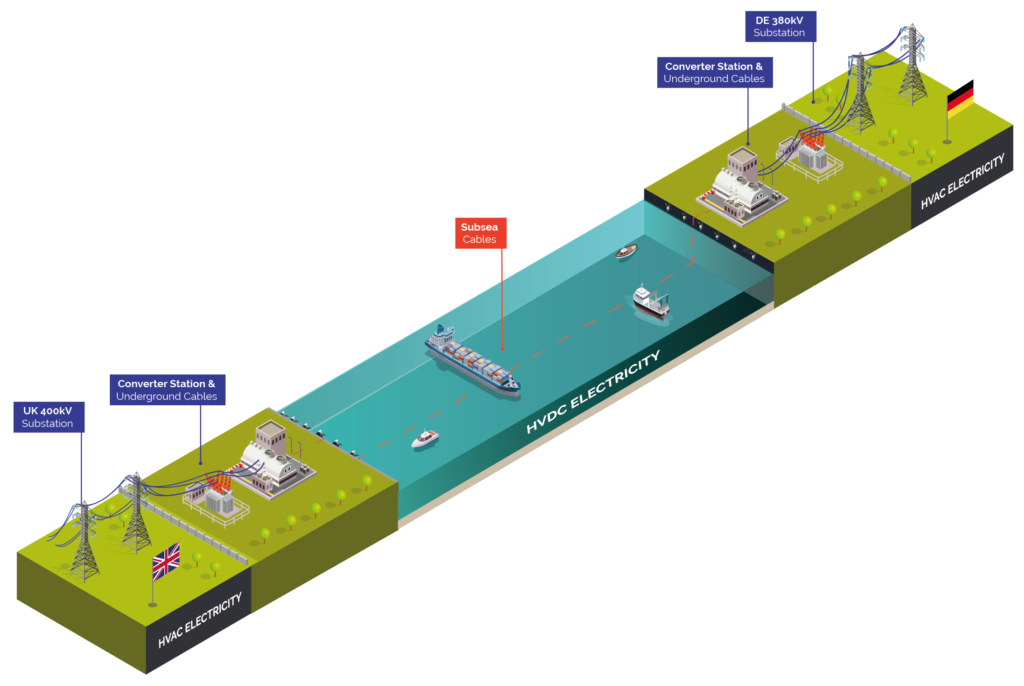
- The Tyrrhenian Link: https://www.terna.it/en/projects/public-engagement/Tyrrhenian-link +
- Connecting Sicily with Sardinia and the Italian peninsula via a double underwater cable: a new electricity corridor at the centre of the Mediterranean; the Tyrrhenian Link. At 950 kilometres long and with a capacity of 1000 MW, this is an infrastructure initiative of international significance, another step towards a more sustainable energy future. The link will improve electricity exchange capacity, facilitate the development of renewable energy sources, and the reliability of the grid.
- The overall project involves two sections: EAST from Sicily to Campania and WEST from Sicily to Sardinia.
- The East section is 480 kilometres long and connects the Fiumetorto landing point, in the municipality of Termini Imerese in Sicily, with the landing point in Torre Tuscia Magazzeno, near Battipaglia in Campania.
- The WEST section is approximately 470 kilometres long and connects the Fiumetorto landing point to the one in Terra Mala, in Sardinia.

- The Viking Link: https://viking-link.com +
- World’s longest power interconnection. the Viking Link is a 1400 MW high voltage direct current (DC) electricity link between the British and Danish transmission systems connecting at Bicker Fen substation in Lincolnshire and Revising substation in southern Jutland, Denmark.

- The North Sea Link: https://northsealink.com/ + North Sea Link is a 720 kilometre subsea interconnector linking the electricity systems of the UK and Norway. The 1400 megawatt interconnector stretches from Blyth in the UK, across the North Sea, to Kvilldal in Norway.
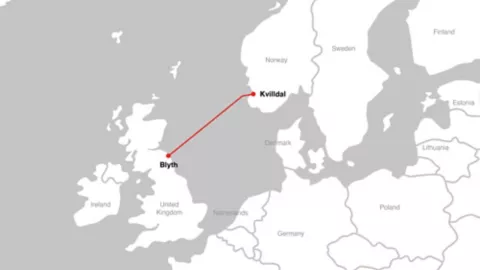
- The Hertel–New York interconnection line: https://www.hydroquebec.com/projects/hertel-new-york-interconnection/ + The Hertel–New York interconnection line project aims to supply clean, renewable energy to New York City. In Québec, the project involves the construction of a line that will span 57.7 km (56.1 km underground and 1.6 km underwater). This 400-kV direct current line will connect Hertel substation in La Prairie to an interconnection point in the Rivière Richelieu at the Canada–United States border.

- The Biscay Gulf Project: https://www.inelfe.eu/en/projects/bay-biscay + The electricity interconnection between Gatika (Spain) and Cubnezais (France) will be the first fundamentally submarine interconnection between Spain and France. This project will increase the exchange capacity from 2,800 to 5,000 MW, improving the safety, stability and quality of electricity supply between the two countries and also with the rest of Europe.
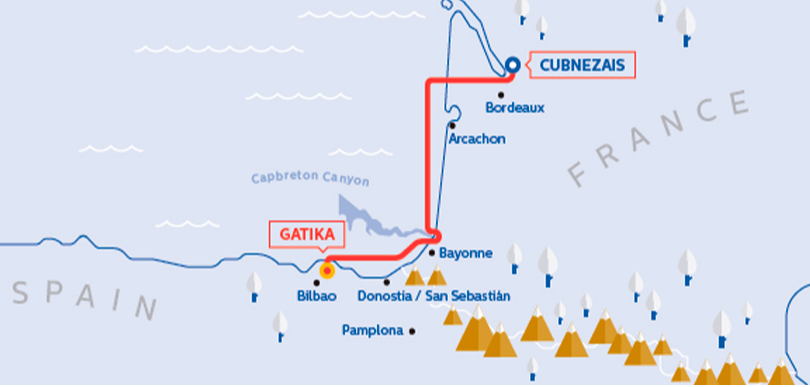
- The Eastern Green Link 2 (EGL2): https://www.ssen-transmission.co.uk/projects/project-map/eastern-green-link-2/ + The Eastern Green Link 2 project is a proposal to install a sub-sea high-voltage direct current (HVDC) cable from Sandford Bay, at Peterhead, to Drax in England. There is currently a large amount of forecasted generation that will require connection to the electricity network in the coming years and as such we are proposing several upgrades to the transmission network across the north of Scotland to facilitate this. The Eastern HVDC Link will play a key role in helping achieve our Net-Zero targets.
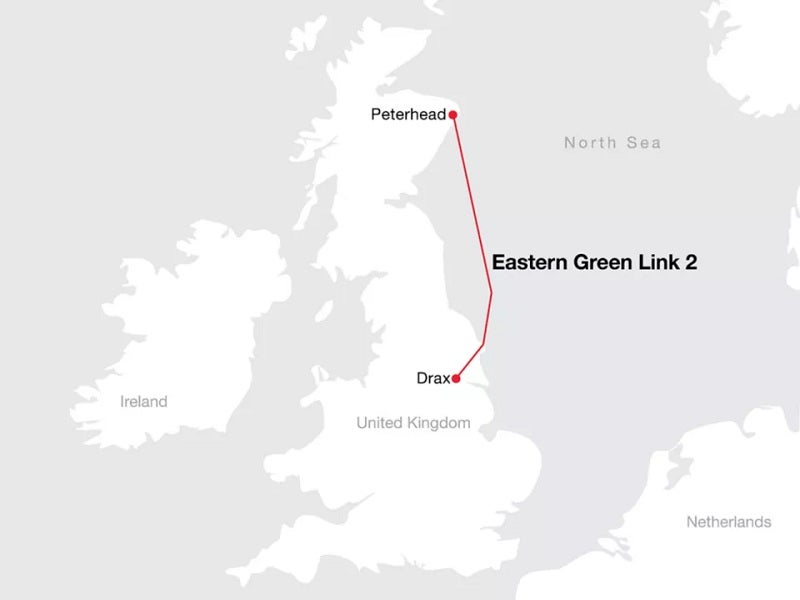
- The EuroAsia Interconnector: https://euroasia-interconnector.com/ + EuroAsia Interconnector Limited is the official EU project developer of the 2,000MW electricity interconnector between Israel, Cyprus, Greece and Europe. The EuroAsia Interconnector is a leading European Project of Common Interest (PCI) labelled as an EU “electricity highway” connecting the national electricity grids of Israel, Cyprus and Greece through a 1,208 km subsea HVDC cable.
- The EuroAsia Interconnector comprises the electricity interconnection between the grids of Israel, Cyprus, Greece through a subsea DC cable and with HVDC onshore converter stations at each connection point, with a total capacity of 2000MW. The project is an energy highway bridging Asia and Europe, with a total length of 1,208 km. It creates a reliable alternative route for the transfer of electric energy to and from Europe.
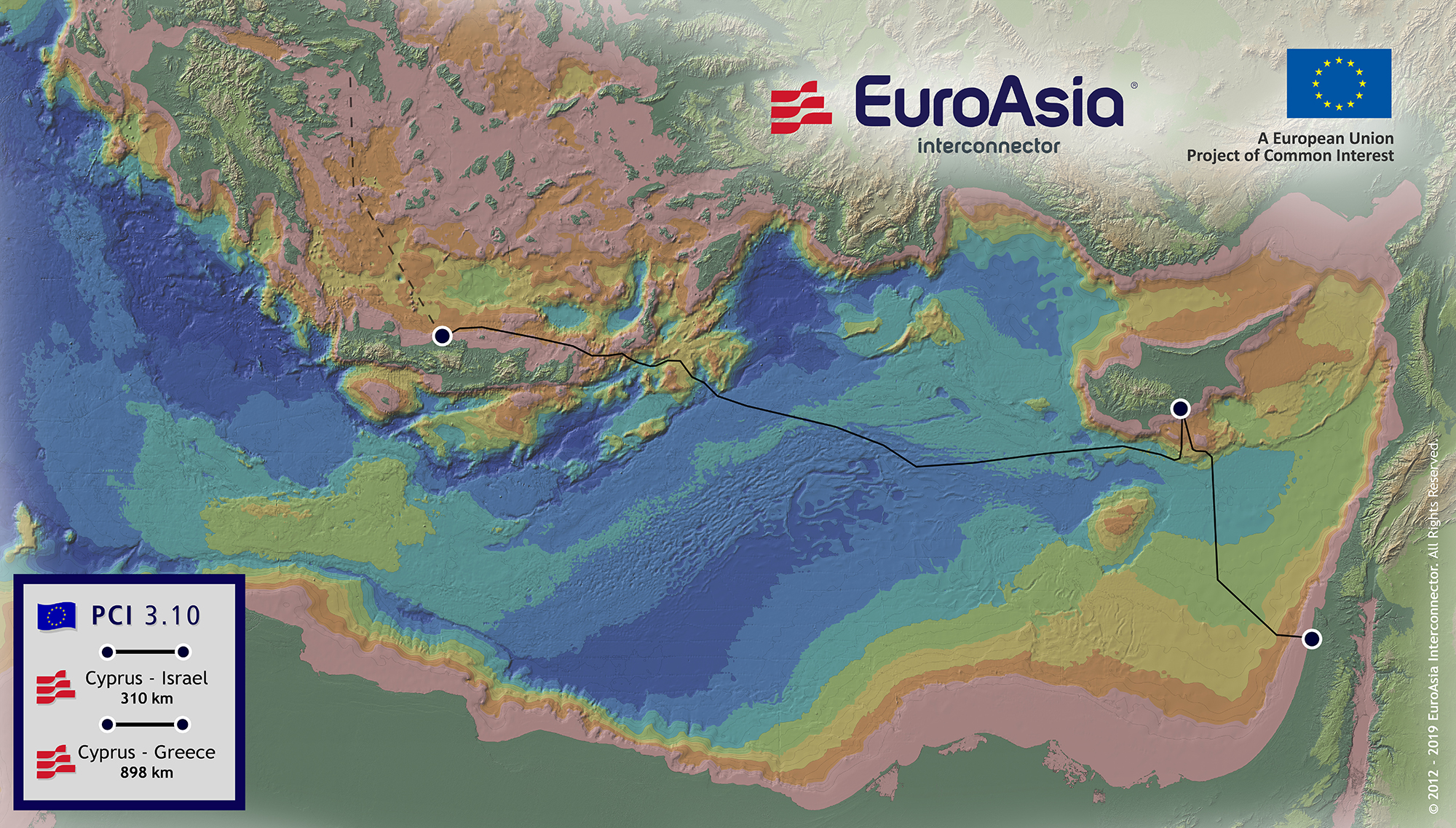
- Kilowatt (kW):
- A kilowatt is simply a measure of how much power an electric appliance consumes—it’s 1,000 watts to be exact. You can quickly convert watts (W) to kilowatts (kW) by diving your wattage by 1,000: 1,000W 1,000 = 1 kW.
- Megawatt (MW):
- One megawatt equals one million watts or 1,000 kilowatts, roughly enough electricity for the instantaneous demand of 750 homes at once.
- Gigawatt (GW):
- A gigawatt (GW) is a unit of power, and it is equal to one billion watts.
- According to the Department of Energy, generating one GW of power takes over three million solar panels or 310 utility-scale wind turbines
- Terawatt (TW):
- One terawatt is equal to 1,000,000,000,000 watts.
- The main use of terawatts is found in the electric power industry.
- According to the United States Energy Information Administration, America is one of the largest electricity consumers in the world using about 4,146.2 terawatt-hours.
- Carbon Dioxide (CO2):
- Primary greenhouse gas emitted through human activities. Carbon dioxide enters the atmosphere through burning fossil fuels (coal, natural gas, and oil), solid waste, trees and other biological materials, and also as a result of certain chemical reactions (e.g., manufacture of cement). Carbon dioxide is removed from the atmosphere (or “sequestered”) when it is absorbed by plants as part of the biological carbon cycle.
- Biogenic Carbon Dioxide (CO2):
- Biogenic Carbon Dioxide (CO2) and Carbon Dioxide (CO2) are the same. Scientists differentiate between biogenic carbon (that which is absorbed, stored and emitted by organic matter like soil, trees, plants and grasses) and non-biogenic carbon (that found in all other sources, most notably in fossil fuels like oil, coal and gas).
- Carbon Capture and Storage (CCS):
- CCS involves the capture of carbon dioxide (CO2) emissions from industrial processes. This carbon is then transported from where it was produced, via ship or in a pipeline, and stored deep underground in geological formations.
- CCS projects typically target 90 percent efficiency, meaning that 90 percent of the carbon dioxide from the power plant will be captured and stored.
- Decarbonization:
- Reduction of carbon dioxide emissions through the use of low carbon power sources, achieving a lower output of greenhouse gasses into the atmosphere.
- Carbon Footprint:
- There is no universally agreed definition of what a carbon footprint is.
- A carbon footprint is generally understood to be the total amount of greenhouse gas (GHG) emissions that are directly or indirectly caused by an individual, organization, product, or service. These emissions are typically measured in tonnes of carbon dioxide equivalent (CO2e).
- In 2009, the Greenhouse Gas Protocol (GHG Protocol) published a standard for calculating and reporting corporate carbon footprints. This standard is widely accepted by businesses and other organizations around the world. The GHG Protocol defines a carbon footprint as “the total set of greenhouse gas emissions caused by an organization, directly and indirectly, through its own operations and the value chain.”
- CO2e:
- CO2e means “carbon dioxide equivalent”. In layman’s terms, CO2e is a measurement of the total greenhouse gases emitted, expressed in terms of the equivalent measurement of carbon dioxide. On the other hand, CO2 only measures carbon emissions and does not account for any other greenhouse gases.
- A carbon dioxide equivalent or CO2 equivalent, abbreviated as CO2-eq is a metric measure used to compare the emissions from various greenhouse gases on the basis of their global-warming potential (GWP), by converting amounts of other gases to the equivalent amount of carbon dioxide with the same global warming potential.
- Carbon dioxide equivalents are commonly expressed as million metric tonnes of carbon dioxide equivalents, abbreviated as MMTCDE.
- The carbon dioxide equivalent for a gas is derived by multiplying the tonnes of the gas by the associated GWP: MMTCDE = (million metric tonnes of a gas) * (GWP of the gas).
- For example, the GWP for methane is 25 and for nitrous oxide 298. This means that emissions of 1 million metric tonnes of methane and nitrous oxide respectively is equivalent to emissions of 25 and 298 million metric tonnes of carbon dioxide.
- Carbon Credits or Carbon Offsets:
- Permits that allow the owner to emit a certain amount of carbon dioxide or other greenhouse gases. One credit permits the emission of one ton of carbon dioxide or the equivalent in other greenhouse gases.
- The carbon credit is half of a so-called cap-and-trade program. Companies that pollute are awarded credits that allow them to continue to pollute up to a certain limit, which is reduced periodically. Meanwhile, the company may sell any unneeded credits to another company that needs them. Private companies are thus doubly incentivized to reduce greenhouse emissions. First, they must spend money on extra credits if their emissions exceed the cap. Second, they can make money by reducing their emissions and selling their excess allowances.
- XLPE:
- Cross-linked polyethylene, commonly abbreviated PEX, XPE or XLPE, is a form of polyethylene with cross-links.
- XLPE or Cross-linked polyethylene is a thermoset insulation material. Crosslinking polymers is a process which changes the molecular structure of the polymer chains so that they are more tightly bound together and this crosslinking is done either by chemical means or physical means.
- XLPE is suitable for voltage ranges from low to extra high voltage, surpassing other insulation materials such as PVC, Ethylene Propylene Rubber (EPR) and silicone rubbers. Cross-linking the polyethylene also enhances the chemical and oil resistance at elevated temperatures and makes it suitable for use as a Low Smoke Zero Halogen material.
- AC (Alternating Current) & DC (Direct Current) & UC (Universal Current):
- Direct current (DC) is an electric current that is uni-directional, so the flow of charge is always in the same direction. As opposed to alternating current, the direction and amperage of direct currents do not change. It is used in many household electronics and in all devices that use batteries.
- Direct current has many uses, from the charging of batteries to large power supplies for electronic systems, motors, and more. Very large quantities of electrical energy provided via direct-current are used in smelting of aluminum and other electrochemical processes.
- in contrast to AC power, DC power is entirely made up of active power, meaning that there are almost no losses due to the capacitance of wires when DC power travels long distances. In fact, high voltage AC transmission systems have losses of 7% to 15% with aboveground transmission.
- Alternating Current is used in homes as Direct current can not be easily stepped up or stepped down with the help of transformers whereas alternating current can easily be converted from low voltage to high voltage or vice-versa with the help of transformers.
- “UC” is used for “Universal Current”, that translates to “either DC or AC”. So a 24 V UC input can accept either 24 V AC or 24 V DC.


